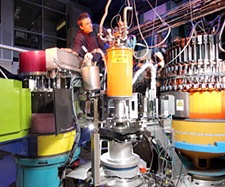Magnetic interactions bring about the formation of cooper pairs and allow unconventional superconductivity
15 Dec 2010
Physics is sometimes just like a criminal investigation. Researchers gather one piece of evidence after another in order to solve a mystery - for example, the question as to how unconventional superconductivity is caused, something which is also of particular interest for technical applications.
 An international team involving scientists at the Max Planck Institute for Chemical Physics of Solids has now provided the strongest evidence yet that magnetic interactions can bring about this form of zero-resistance current transport - something that physicists have been gathering evidence for, for some time.
An international team involving scientists at the Max Planck Institute for Chemical Physics of Solids has now provided the strongest evidence yet that magnetic interactions can bring about this form of zero-resistance current transport - something that physicists have been gathering evidence for, for some time.
It is becoming more and more apparent that a notorious troublemaker can also be cooperative: conventional superconductivity in normal metals is namely easily destroyed by magnetic fields. The fact that magnetism makes unconventional superconductivity possible, however, could also provide clues in the search for new materials that transport current without loss in day-to-day applications. (Nature Physics, online publication, December 12, 2010).
The picture that physicists have of unconventional superconductors is gradually becoming clearer. These materials also include the complexly-structured ceramic materials which conduct current without losses, even at relatively high temperatures. These temperatures are still below minus 135 degrees Celsius, however - too cold for wide-scale everyday application.
In order to systematically shift this limit to a higher value, physicists first have to understand how the superconductivity arises in these materials. "Our findings make an important contribution to this understanding," says Frank Steglich, director at the Max Planck Institute for Chemical Physics of Solids in Dresden and head of the investigation. One of the things that the researchers have discovered is that the magnetic interactions in the material provide enough energy to put the material into the superconducting state.
The researchers working with Frank Steglich collaborated with colleagues from the Jülich Center for Neutron Science at the Institut Laue-Langevin in Grenoble, the TU Dresden, Rice University in Houston, Texas and the Max Planck Institute for the Physics of Complex Systems in Dresden to investigate CeCu2Si2 - a chemical compound of cerium, copper and silicon.






























